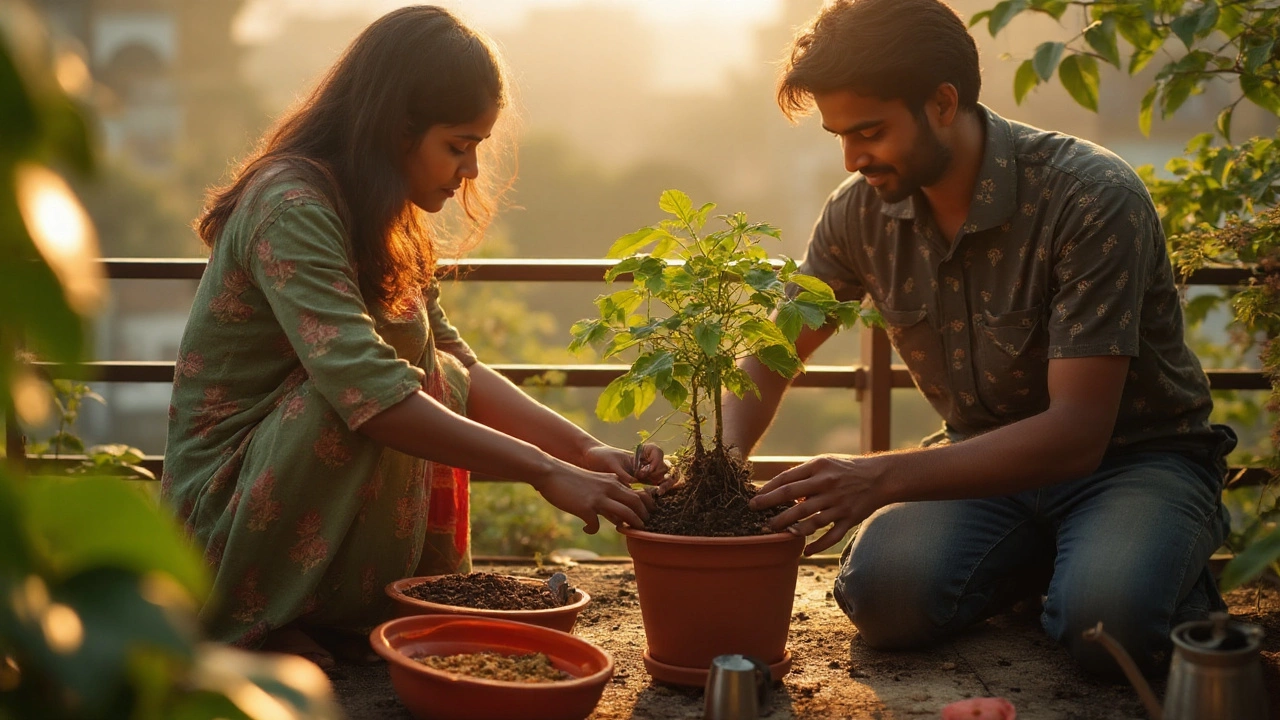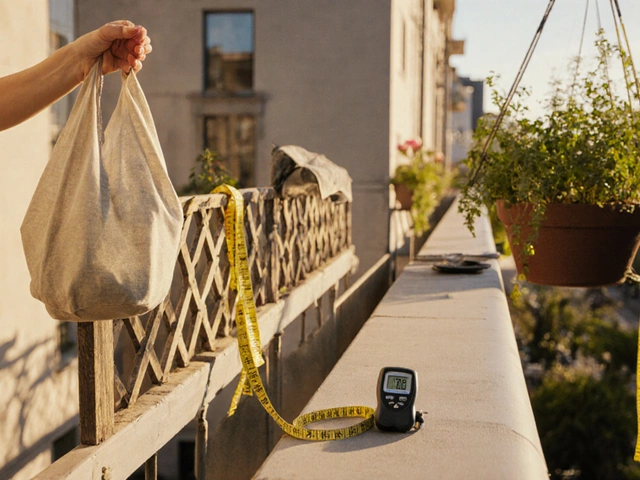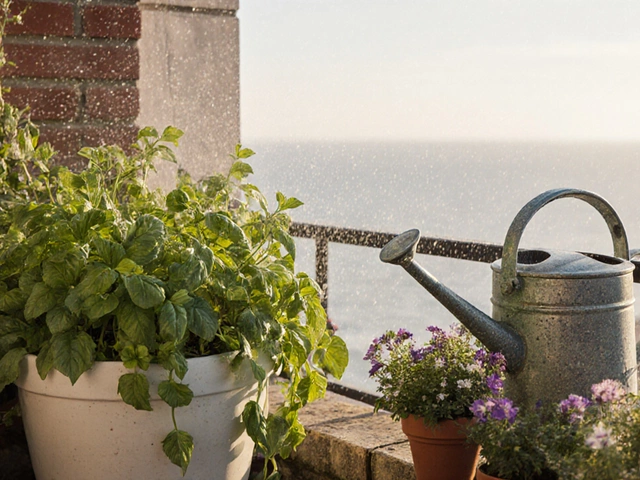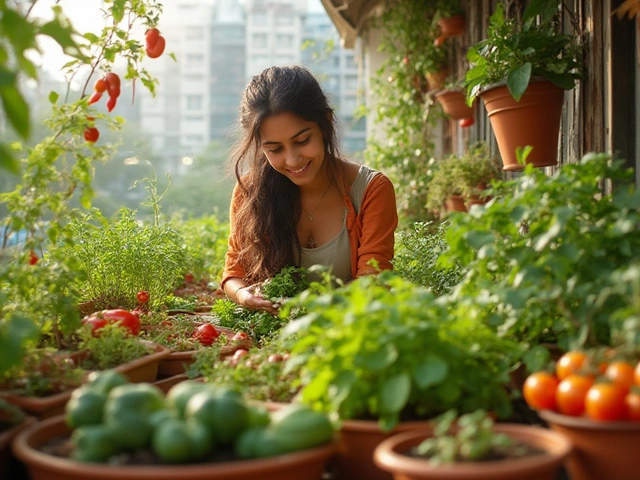You clicked because you want one simple rule of thumb for pots. Fair. Here’s the honest bit: there isn’t just one. Containers are a tiny ecosystem, so the real win is a short set of rules that always stack the odds in your favour-size, soil, water, light, and feeding. Nail those, and you’ll grow almost anything on a balcony, patio, or doorstep. I garden on a windy balcony in Brighton, so I keep this tight and practical.
TL;DR
- Size: Bigger pot = happier plant. Aim for 20-30 L for tomatoes; 10-15 L for peppers; 5-7 L for salads; 3-5 L for herbs.
- Soil: Use peat-free mix plus 20-30% perlite/bark for drainage. Never use garden soil in pots.
- Water: Finger test daily in warm weather. Water until 10-20% drains out; mulch 3-5 cm to slow evaporation.
- Light: 6-8 hours for fruiting crops; 3-5 hours is fine for leafy herbs and salads.
- Feed: Slow-release at planting, then a light liquid feed weekly in peak growth (“weekly, weakly”).
What you likely want to get done:
- Pick the right pot size without guessing.
- Mix a potting blend that drains well but doesn’t dry in a day.
- Water on a simple, repeatable schedule that actually works.
- Match plants to your light and wind situation (hello, coastal gusts).
- Feed without overthinking NPK numbers.
- Prevent the big fails: root rot, scorch, and nutrient washout.
The core rules of thumb that actually work
Here are the rules I use and teach. They’re simple on purpose, but they’re backed by what the RHS and university extension guides repeat year after year: big enough pot, free-draining peat-free mix, consistent moisture, enough light, and steady feeding.
1) Pot size and spacing
- Herbs (thyme, oregano, mint): 3-5 L per plant. Mint likes its own pot.
- Leafy salads (lettuce, rocket, spinach): 5-7 L per planting area; 15-20 cm between plants.
- Peppers/chillies: 10-15 L per plant; stake early.
- Tomatoes (bush or cordon): 20-30 L per plant; 30 L is better for less watering drama.
- Courgette: 30-40 L; give it space-one plant per pot.
- Dwarf fruit trees or small shrubs: 40-60 L; choose frost-proof pots.
Quick sizing shortcut: if the mature plant’s canopy will be the size of a football, give it ~10-15 L. If it’s two footballs, go 20-30 L. Roots and water stores are happier in bigger volumes.
2) Drainage and pot setup
- At least one large drainage hole per 20 cm of pot diameter; more is better.
- Skip gravel at the bottom-it creates a perched water table. Use an even soil profile.
- Raise pots on feet or slats so water actually escapes, especially on patios.
- Use a saucer in summer to catch runoff; empty after 30 minutes to avoid soggy roots.
This matches what horticulture labs have shown: pot layers don’t drain the way people think. Water moves best through consistent media.
3) Soil mix (peat-free) that doesn’t disappoint
- Base: quality peat-free multipurpose compost.
- Add 20-30% perlite or fine bark for drainage and air.
- Mix in a balanced slow-release fertiliser at label rate.
- Option: 10% worm castings for resilience and microbial life.
A good peat-free blend holds moisture without turning to sludge. The RHS has long recommended peat-free for sustainability and performance when it’s well-structured.
4) Light: match plant to balcony conditions
- Fruiting crops (tomatoes, peppers, aubergines): 6-8 hours direct sun.
- Leafy greens and many herbs: 3-5 hours direct sun or bright dappled light.
- Morning sun beats harsh afternoon sun on hot balconies.
- Wind is a hidden thief-use screens or group pots to cut wind stress.
On my Brighton balcony, I use a mesh windbreak that drops wind by about a third. Leaves transpire less, so I water less and get fewer crispy edges.
5) Watering: the three-test system
- Finger test: top 2-3 cm should feel dry before you water again.
- Lift test: learn the weight of a just-watered pot vs. light and dry-this is reliable.
- Drain test: water until 10-20% runs out the bottom to flush salts and wet the whole root zone.
Frequency cheat: small pots (under 7 L) often need daily water in warm weather; 10-15 L every other day; 20-30 L two to three times a week. Early morning is best-cooler, less evaporation, and fewer fungal risks than at night.
Mulch matters: add 3-5 cm of straw, fine bark, or even clean pebbles to reduce evaporation by up to a third. In heatwaves, a light shade cloth during the fiercest sun saves leaves.
6) Feeding: steady and light beats feast and famine
- At planting: slow-release fertiliser mixed in.
- Growth phase: a half-strength liquid feed weekly (yes, the “weekly, weakly” rule holds up).
- For tomatoes and peppers: switch to a high-potash feed when flowers appear; it encourages fruiting over leafy growth.
Containers leach nutrients with every watering, which is why little-and-often feeding is consistent with extension recommendations. If leaves pale evenly, you’re underfeeding; if tips brown and crust forms on soil, you might be overdoing it.
7) Spacing, staking, and grouping
- Spacing: avoid leaf overlap early; good airflow dodges mildew.
- Staking: get supports in at planting so you don’t damage roots later.
- Group by water needs: thirsty crops together, drought-tolerant herbs together. It simplifies watering.
8) Seasonal care
- Spring: harden off seedlings a week before full outdoor life; increase sun slowly.
- Summer: mulch, shade in heat spikes, water morning.
- Autumn: top-dress with fresh compost; prune and tidy; empty spent pots.
- Winter: lift pots on feet, move tender plants to shelter, and wrap pots to protect roots from freeze-thaw.
9) Common mistakes to avoid
- Pot too small-leads to stress, tip burn, and constant watering.
- No drainage-roots suffocate and rot.
- Heavy mixes-waterlogged, low oxygen.
- Overfeeding in heat-salts build up and burn roots.
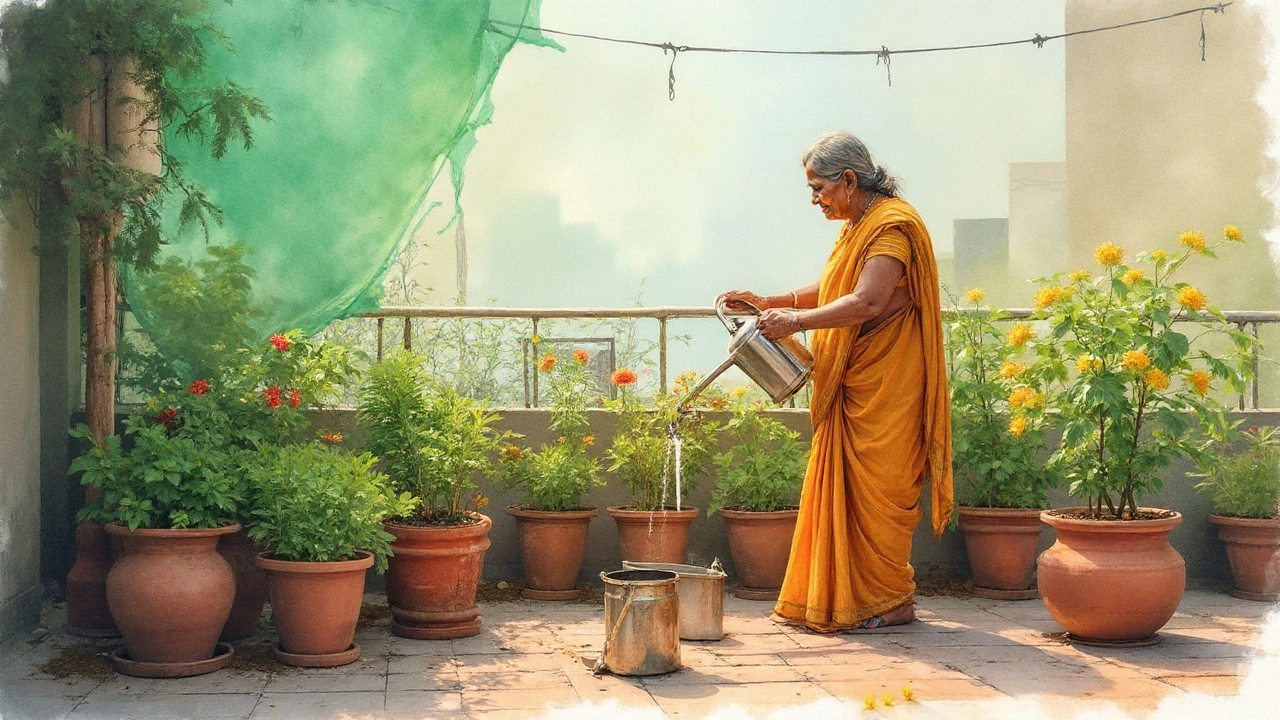
Step-by-step: build it right, then water and feed on autopilot
Here’s the simplest repeatable method I use for nearly every plant. Once you’ve done it twice, it’s muscle memory.
- Choose the pot: Use the size list above. Check for multiple drainage holes. Add pot feet.
- Prep the mix: 70-80% peat-free compost + 20-30% perlite/fine bark. Add slow-release fertiliser at label rate.
- Fill and settle: Fill to 4 cm below the rim. Tap the pot to settle; don’t compact hard.
- Plant: Set the plant so the crown sits level with the soil surface (tomatoes are an exception-you can bury the stem a bit to encourage roots).
- Water in: Water slowly until it drains. Wait 10 minutes, then water once more.
- Mulch: Add 3-5 cm of straw/bark/pebbles to reduce evaporation and soil splash.
- Place: Sunny, sheltered spot if possible. Rotate pots weekly for even growth.
- Feed routine: After 2-3 weeks, start half-strength liquid feed weekly. For fruiting crops, switch to high potash at flowering.
- Check routine: Daily quick scan-tip burn, droop, pests. Fix early, it’s easy.
Quick-reference cheat sheets
- Soil moisture test order: look → touch → lift. If two say “dry,” water.
- Heatwave rule: shade in the hottest hours, water early morning and, if needed, a light second watering late afternoon (not at night).
- Rain doesn’t count in summer: leaves catch it; soil stays dry. Check the compost, not the weather app.
- Repot calendar: fast annuals-refresh or repot each season; perennials-top-dress each spring, full repot every 2-3 years.
Examples that just work (Brighton-tested)
Salad bowl (easy win)
- Pot: 35-40 cm wide, ~10 L total.
- Mix: standard peat-free + perlite.
- Plant: 6-8 loose-leaf lettuces or a mixed cut-and-come-again seed mix.
- Light: 3-5 hours sun.
- Water: every 1-2 days in warm weather; mulch lightly.
- Feed: half-strength liquid feed every 10-14 days.
Patio tomato (the favourite)
- Pot: 30 L, stout stake or cage ready.
- Plant: bush or cordon variety suited to containers.
- Light: 6-8 hours sun, with wind protection.
- Water: deep, 2-3 times/week; consistent moisture reduces blossom-end rot.
- Feed: high potash once flowers appear; keep it light but steady.
Herb trio (no-fuss)
- Pot: 30-35 cm, 10-12 L total.
- Plants: rosemary (upright back), thyme and oregano (front edge). Keep mint separate.
- Light: sun to light shade, good airflow.
- Water: when top 3 cm dries; these prefer the drier side.
- Feed: minimal; a monthly light feed in summer is enough.
Pollinator pot (for colour and bees)
- Pot: 30-40 cm, 10-15 L.
- Plants: dwarf lavender, calibrachoa, trailing lobelia.
- Light: full sun.
- Water: 2-3 times/week; mulch to reduce splash.
- Feed: flower-focused liquid feed every 10-14 days mid-season.
If X, then Y: decision prompts
- Leaves droop at day’s peak but perk up at night → underwatered or heat-stressed. Mulch, morning water, add light shade.
- Lower leaves yellow evenly → probably underfeeding. Resume weekly half-strength feeding.
- Leaf edges brown and crispy, white crust on soil → salt build-up from fertiliser. Flush with plain water until lots drains.
- Plants lean away from wind → move, group for shelter, or add a windbreak.
- Fungus gnats flying up from soil → let top 3 cm dry between waterings, add a thin layer of grit, use sticky traps.
Simple safety and sustainability notes
- Food-safe containers matter for edibles. If reusing buckets or tubs, confirm what they held before.
- Go peat-free and reuse last season’s compost by blending 50:50 with fresh mix plus fertiliser; sieve out big roots first.
- Check local water guidance if restrictions pop up; install a simple capillary mat or bottle spike to reduce waste.
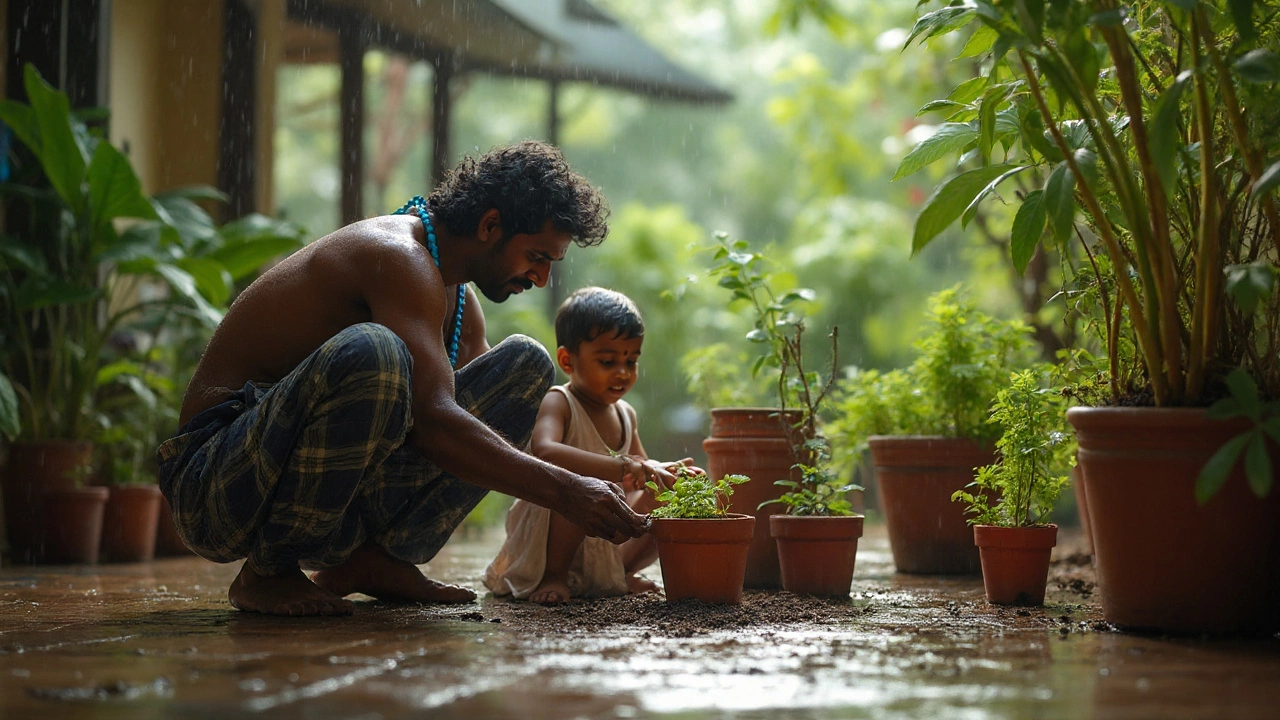
FAQ, troubleshooting, and your next steps
What is the one rule of thumb for container gardening? If I had to pick a single rule, it’s this: choose a bigger pot than you think you need and use a free-draining peat-free mix. Bigger volume buffers against watering mistakes and heat; good structure keeps roots oxygenated.
How often should I water? In warm weather: small pots daily, 10-15 L every other day, 20-30 L two to three times per week. Use the finger and lift tests to confirm. Always water to runoff when you do water.
Do I really need mulch in a pot? Yes. A 3-5 cm top layer keeps moisture in, stops soil splash (which spreads disease), and evens out temperature swings. It’s a small step with big results.
Peat-free is fine? Yes. Quality peat-free mixes work brilliantly with added perlite or fine bark. RHS trials have shown peat-free can match peat when you manage water and feed well.
Can I use garden soil? Not in pots. It compacts, drains poorly, and may bring pests and diseases. Use compost designed for containers.
What about wind on a balcony? Wind is major on UK coasts. Use mesh windbreaks, place taller pots as shields, and choose squat, heavy containers to prevent tipping. Water a bit deeper but less often than light sips-deep roots cope better.
Why are my tomato leaves curling? Usually heat, wind, or inconsistent watering. Stabilise moisture, shield from wind, and avoid heavy feeds all at once. Curl without yellowing isn’t always a crisis.
Blossom-end rot on tomatoes-what did I do wrong? It’s usually uneven watering, not a calcium shortage in the compost. Keep moisture steady and mulch. Fruits that already show it won’t fix, but new ones will be fine once you stabilise.
Slugs in pots-help? Raise pots, use copper tape or wool pellets, and keep the area tidy. Hand-pick at dusk if you can. Slugs love damp saucers; empty them.
How do I refresh tired potting mix? For annuals: tip out, remove old roots, blend 50% fresh compost and perlite, add slow-release fertiliser. For perennials: scrape off the top 5-8 cm and replace with fresh compost plus a handful of slow-release granules.
Can I grow blueberries in regular compost? Use ericaceous compost for acid lovers like blueberries and camellias, or they sulk. Keep the pH low or yields drop.
Next steps, based on your situation
- Small balcony, windy (coastal): Choose squat 20-30 L pots, add pot feet, and a mesh windbreak. Grow bush tomatoes, chillies, chard, thyme, and rosemary. Water deep, early.
- Renting, moving soon: Stick to 10-15 L lightweight resin pots with handles. Grow salads, herbs, and compact peppers. Use capillary trays so a neighbour can water once while you’re away.
- Busy schedule: Self-watering pots or a simple wicking setup. Mulch everything. Plant fewer, larger containers; they’re more forgiving.
- Growing with kids: Fast wins like radishes, strawberries in hanging baskets, and bush beans in 10-12 L pots. Let them do the finger test; it teaches when to water.
Troubleshooting quick map
- Wilting + wet compost → root rot risk. Improve drainage, add perlite, water only when top 3 cm dries.
- Wilting + dry compost → simple: water to runoff, add mulch, shade the pot for a day.
- Yellow leaves + green veins → magnesium deficiency. A magnesium feed can help; keep overall feeding steady.
- Pale growth after a downpour week → nutrients washed out. Resume half-strength feed.
- Plants topple in storms → heavier, wider pots; move closer to house wall; stake earlier.
A seasonal nudge for right now
If you’re reading this mid-season, you can still upsize any plant that feels forever thirsty or stunted. Slide it out, set it into a pot one size up with fresh mix, water well, and mulch. The difference in a week will surprise you.
Container success isn’t luck. It’s a small set of habits you can do on autopilot: right pot, airy peat-free mix, consistent moisture, enough light, and light, regular feeding. Do those, and even a windy balcony can become a steady little harvest.
